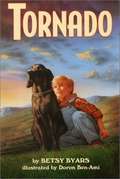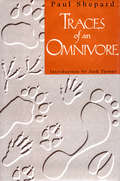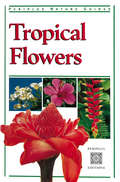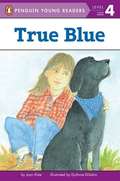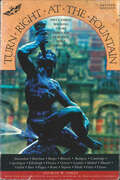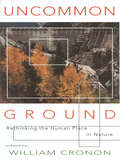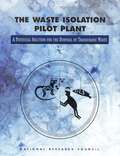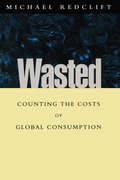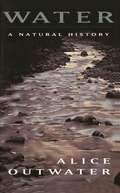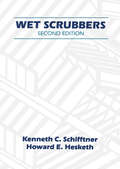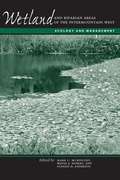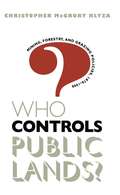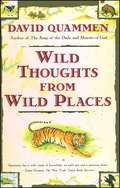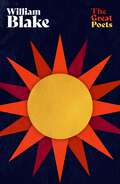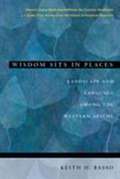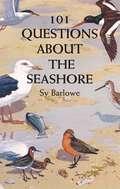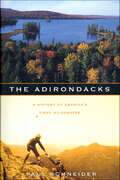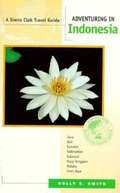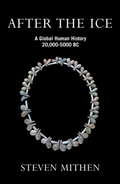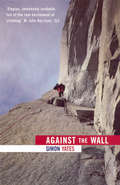- Table View
- List View
Tornado
by Betsy ByarsA tornado is coming, and once Pete the farmhand gathers the family safely in the storm cellar, he distracts them with a favorite tale about a tornado from his childhood--and the surprise it brought: Among the debris left by this twister was a doghouse, complete with a dog inside! Pete goes on to tell more stories about this hole-digging, cardtrick-playing dog, aptly named Tornado; and it isn't hard to see how Tornado, and the stories about him, soon become a part of both past and present families.
Traces of an Omnivore
by Jack Turner Paul ShepardPaul Shepard is one of the most profound and original thinkers of our time. He has helped define the field of human ecology, and has played a vital role in the development of what have come to be known as environmental philosophy, ecophilosophy, and deep ecology -- new ways of thinking about human-environment interactions that ultimately hold great promise for healing the bonds between humans and the natural world. Traces of an Omnivore presents a readable and accessible introduction to this seminal thinker and writer. Throughout his long and distinguished career, Paul Shepard has addressed the most fundamental question of life: Who are we? An oft-repeated theme of his writing is what he sees as the central fact of our existence: that our genetic heritage, formed by three million years of hunting and gathering remains essentially unchanged. Shepard argues that this, "our wild Pleistocene genome," influences everything from human neurology and ontogeny to our pathologies, social structure, myths, and cosmology. While Shepard's writings travel widely across the intellectual landscape, exploring topics as diverse as aesthetics, the bear, hunting, perception, agriculture, human ontogeny, history, animal rights, domestication, post-modern deconstruction, tourism, vegetarianism, the iconography of animals, the Hudson River school of painters, human ecology, theoretical psychology, and metaphysics, the fundamental importance of our genetic makeup is the predominant theme of this collection. As Jack Turner states in an eloquent and enlightening introduction, the essays gathered here "address controversy with an intellectual courage uncommon in an age that exults the relativist, the skeptic, and the cynic. Perused with care they will reward the reader with a deepened appreciation of what we so casually denigrate as primitive life -- the only life we have in the only world we will ever know."
Tropical Flowers
by William WarrenLearn all about beautiful tropical flowers with this useful and portable reference book. This handy pocket guide introduces 55 plant species commonly found in the Tropics. Each exotic bloom is described in detail, its history of origination discussed and gardening tips are given. Illustrated with over 120 beautiful color photographs, this book contains a wealth of botanical details, as well as fascinating information on the cultural uses of flowers. A "must" for gardeners and non-gardeners alike Periplus Handy Pocket Guides are practical field guides, useful for identifying various natural objects ranging from plants and animals to gemstones and seashells. Each page of each title throughout the series is filled with clear, precise photographs and informative text. Scientific and local language names are given.
True Blue
by Joan ElsteBlue has a very sharp nose. He can smell trouble from a mile away. But now Blue has disappeared and might be in trouble himself! Blue will have to be very brave if he wants to make it home to his owner, J. D.
Turn Right at the Fountain: Fifty-Three Walking Tours Through Europe's Most Enchanting Cities
by George W. Oakes Alexandra ChapmanOriginally published in 1961 and written by George W. Oakes, chief travel writer for the New York Times, this beloved walking guide has sold more than 100,000 copies in several editions. Now completely revised and updated by Alexandra Chapman, this latest edition features intimate walks through twenty-one of Europe's most celebrated cities, including an all-new chapter on Budapest, the Paris of the Danube. With this book as a guide, stroll through the winding cobblestone streets of Florence, gaze at the breath-takingly beautiful lawns of Cambridge, and explore the dark mysteries of Prague's architectural gems.Each walk is comfortably planned to take no more than a leisurely morning or afternoon, highlighting the not-to-be-missed museums, churches, and monuments as well as less conspicuous but equally charming sites. These tours offer explicit directions keyed to thirty-two easy-to-follow maps, concise descriptions of sights along the routes, and brief historical notes about buildings and other places of interest. From Amsterdam to Segovia, these expertly designed walking tours unveil the immense cultural treasures that these magical cities hold-treasures best enjoyed on foot.
Uncommon Ground: Rethinking the Human Place in Nature
by William CrononA controversial, timely reassessment of the environmentalist agenda by outstanding historians, scientists, and critics. In a lead essay that powerfully states the broad argument of the book, William Cronon writes that the environmentalist goal of wilderness preservation is conceptually and politically wrongheaded. Among the ironies and entanglements resulting from this goal are the sale of nature in our malls through the Nature Company, and the disputes between working people and environmentalists over spotted owls and other objects of species preservation. The problem is that we haven't learned to live responsibly in nature. The environmentalist aim of legislating humans out of the wilderness is no solution. People, Cronon argues, are inextricably tied to nature, whether they live in cities or countryside. Rather than attempt to exclude humans, environmental advocates should help us learn to live in some sustainable relationship with nature. It is our home.
A Walk Through The Heavens
by Milton D. Heifetz Wil TirionA Walk through the Heavens is a guide to the pathways of the sky. It contains unique, simplified maps of the constellations and instructions on how to measure their sizes and the separations between them. Using this information you can find the constellations very easily and take a mind's eye journey from one constellation to its neighbours. The ancient myths and legends surrounding the constellations are retold, enriching our understanding of how historical peoples saw the awe-inspiring spectacle of a sky sprinkled with stars. Magically illustrated by Wil Tirion, this book does not assume that the reader has binoculars, and is ideal to inspire the young astronomer just starting out on a journey across the starlit skies.
The Waste Isolation Pilot Plant: A Potential Solution for the Disposal of Transuranic Waste
by Committee on the Waste Isolation Pilot PlantThis volume discusses the readiness of the U.S. Department of Energy's (DOE) Waste Isolation Pilot Plant (WIPP) facility near Carlsbad, New Mexico, to serve as a geological repository for transuranic radioactive waste. WIPP is located in a Permian-age bedded salt deposit 658 meters below the surface. The committee has long reviewed DOE's readiness efforts, now aimed at demonstrating compliance with U.S. Environmental Protection Agency regulations. Site characterization studies and performance assessment modeling are among the topics considered in this volume.
Wasted: Counting the costs of global consumption (Sustainable Development Set Ser.)
by Michael RedcliftSustainable development cannot be achieved solely at the international level. Without the creation of more sustainable livelihoods, it will remain a utopian and elusive goal. Yet given the huge differences in economic development and levels of consumption between North and South, how might this bebrought about?Taking the 1992 Rio Summit as its point of departure, Wasted examines what we now need to know, and what we need to do, to live within sustainable limits. One of the key issues is how we use the environment: converting natural resources into human artifices, commodities and services. In the process of consuming,we also create sinks. Today, these sinks - the empty back pocket in the global biogeographical system - are no longer empty. The fate of the global environment is indissolubly linked to our consumption: particularly in the energy-profligate North.To understand and overcome environmental challenges, we need to build the outcomes of our present consumption rates into our future behaviour: to accept sustainable development as a normative goal for societies; one that is bound up with our everyday social practices and actions. In this absorbing book, Michael Redclift argues that the way we understand and think about the environn1ent conditions our responses, and our ability to meet the challenge, and discusses tangible policies for increased sustainability that are grounded in recent research and practice.MICHAEL RedcliftIs Professor of International Environmental Policy at the Department of Geography, King's College London. He was previously Professor of International Environmental Policy at the University of Keele and before that Professor of Environmental Sociology at Wye College, University of London, and Director of the ESRC Global Environmental Change Programme. He is author and editor of numerous books, including Sustainable Development: Exploring the Contradictions (1987), Social Theory and the Global Environment (1994) and Sustainability: Life Chances and Lifestyles (1999).Originally published in 1996
Water: A Natural History
by Alice OutwaterAn environmental engineer turned ecology writer relates the history of our waterways and her own growing understanding of why our waterways continue to be polluted#151;and what needs to be done to save this essential natural resourse. Water: A Natural History takes us back to the diaries of the first Western explorers; it moves from the reservoir to the modern toliet, from the grasslands of the Midwest to the Everglades of Florida, throught the guts of a wastewater treatment plant and out to the waterways again. It shows how human-engineered dams, canals and farms replaces nature’s beaver dams, prairie dog tunnels, and buffalo wallows. Step by step, Outwater makes clear what should have always been obvious: while engineering can depollute water, only ecologically interacting systems can create healthy waterways. Important reading for students of environmental studies, the heart of this history is a vision of our land and waterways as they once were, and a plan that can restore them to their former glory: a land of living streams, public lands with hundreds of millions of beaver-built wetlands, prairie dog towns that increase the amount of rainfall that percolates to the groundwater, and forests that feed their fallen trees to the sea.
Wet Scrubbers
by Howard D. HeskethA basic technical book on the design and application of gas cleaning technologies that use liquids, first published in the 1980's and used by plant and environmental engineers, regulatory personnel, and others concerned with air pollution. The second edition enlarges the discussion on the theory of
Wetland and Riparian Areas of the Intermountain West: Ecology and Management
by Mark C. Mckinstry Wayne A. Hubert Stanley H. AndersonWetlands and riparian areas between the Rocky Mountains and the Sierra Nevada are incredibly diverse and valuable habitats.<P><P> More than 80 percent of the wildlife species in this intermountain region depend on these wetlands—which account for less than 2 percent of the land area—for their survival. At the same time, the wetlands also serve the water needs of ranchers and farmers, recreationists, vacation communities, and cities. It is no exaggeration to call water the "liquid gold" of the West, and the burgeoning human demands on this scarce resource make it imperative to understand and properly manage the wetlands and riverine areas of the Intermountain West.
Who Controls Public Lands?
by Christopher Mcgrory KlyzaIn this historical and comparative study, Christopher McGrory Klyza explores why land-management policies in mining, forestry, and grazing have followed different paths and explains why public-lands policy in general has remained virtually static over time. According to Klyza, understanding the different philosophies that gave rise to each policy regime is crucial to reforming public-lands policy in the future. Klyza begins by delineating how prevailing policy philosophies over the course of the last century have shaped each of the three land-use patterns he discusses. In mining, the model was economic liberalism, which mandated privatization of public lands; in forestry, it was technocratic utilitarianism, which called for government ownership and management of land; and in grazing, it was interest-group liberalism, in which private interests determined government policy. Each of these philosophies held sway in the years during which policy for that particular resource was formed, says Klyza, and continues to animate it even today.
Wild Thoughts from Wild Places
by David QuammenIn Wild Thoughts from Wild Places, award-winning journalist David Quammen reminds us why he has become one of our most beloved science and nature writers.This collection of twenty-three of Quammen's most intriguing, most exciting, most memorable pieces takes us to meet kayakers on the Futaleufu River of southern Chile, where Quammen describes how it feels to travel in fast company and flail for survival in the river's maw. We are introduced to the commerce in pearls (and black-market parrots) in the Aru Islands of eastern Indonesia. Quammen even finds wildness in smog-choked Los Angeles -- embodied in an elusive population of urban coyotes, too stubborn and too clever to surrender to the sprawl of civilization.With humor and intelligence, David Quammen's Wild Thoughts from Wild Places also reminds us that humans are just one of the many species on earth with motivations, goals, quirks, and eccentricities. Expect to be entertained and moved on this journey through the wilds of science and nature.
William Blake: The very best poems from one of the most important figures of the Romantic Age (The Great Poets)
by William Blake'To see the world in a grain of sand, and to see heaven in a wild flower, hold infinity in the palm of your hands, and eternity in an hour' William BlakeWilliam Blake was a poet and artist. Born in Soho in the eighteenth century, the son of a shopkeeper, he is now acclaimed as a radical left-field artist. Most recently, the Tate held an exhibition of his work: 'Magnificent ... reveal's Blake's vision at its most vivid and strange' GUARDIANBlake's written work was equally vivid. A major poet of the Romantic age, the full range of his poetry includes the joyful and sorrowful, the childlike and complex - and illustrates his original and prophetic vision. Considered mad by contemporaries for his idiosyncratic opinions, he is now revered for the depth of his poetry and art, and the philosophical undercurrents intrinsic to all his creative work.'If the Sun and Moon should ever doubt, they'd immediately go out''The imagination is not a state; it is the human existence itself'
William Blake: The very best poems from one of the most important figures of the Romantic Age (The Great Poets)
by William Blake'To see the world in a grain of sand, and to see heaven in a wild flower, hold infinity in the palm of your hands, and eternity in an hour' William BlakeWilliam Blake was a poet and artist. Born in Soho in the eighteenth century, the son of a shopkeeper, he is now acclaimed as a radical left-field artist. Most recently, the Tate held an exhibition of his work: 'Magnificent ... reveal's Blake's vision at its most vivid and strange' GUARDIANBlake's written work was equally vivid. A major poet of the Romantic age, the full range of his poetry includes the joyful and sorrowful, the childlike and complex - and illustrates his original and prophetic vision. Considered mad by contemporaries for his idiosyncratic opinions, he is now revered for the depth of his poetry and art, and the philosophical undercurrents intrinsic to all his creative work.'If the Sun and Moon should ever doubt, they'd immediately go out''The imagination is not a state; it is the human existence itself'
Wisdom Sits In Places: Landscapes and Language Among the Western Apache
by Keith H. BassoFour essays recount stories Western Apaches tell about the landscape. Includes comments from a cultural anthropologist.
101 Questions About the Seashore
by Sy BarloweHave you ever wondered why the sea is salty or if the ocean ever freezes? Or how starfishes see? If you have, then this fascinating guide to plants and animals that thrive along the ocean's edge is just for you.The veteran illustrator and nature writer Sy Barlowe provides answers to these and scores of other sea-related questions through accurate drawings and concise text about barnacles, sea anemones, mollusks, arthropods, crustaceans, tidal pools, seaweed, shorebirds, quahogs, shipworms, and many other life forms found in shoreline habitats.This informative and lively guide will not only open up new worlds to the reader but will also promote an awareness of seashore environments and the importance of preserving them.
About Mammals: A Guide for Children (About. . . #2)
by Cathryn SillAn award-winning first glimpse into the diverse natural world of mammals.This addition to the acclaimed About... series explains to children in simple, easy-to-understand language what mammals are, what they eat, and where they live. Beautifully detailed, realistic paintings by wildlife illustrator John Sill introduce readers to the huge variety of mammals, from the tiny white-footed deermouse to the large American bison. An afterword provides more details about the animals featured in the book. Parents and pre-school and primary-grade teachers will find this an attractive choice for introducing kids to mammals.
The Adirondacks: A History of America's First Wilderness
by Paul SchneiderHis book is a romance, a story of first love between Americans and a thing they call "wilderness." For it was in the Adirondacks that masses of non-Native Americans first learned to cherish the wilderness as a place of recreation and solace.In this lyrical narrative history, the author reveals that the affair between Americans and the Adirondacks was by no means one of love at first sight. And even now, Schneider shows that Americans' relationship with the glorious mountains and rivers of the Adirondacks continues to change. As in every good romance, nothing is as simple as it appears.
Adventuring in Indonesia: Exploring the Natural Areas of the Pacific's Ring of Fire
by Holly S. SmithIn the latest addition to the Sierra Club Adventure Travel series, Holly Smith provides a wealth of savvy and sensitive advice on both outdoor and cultural opportunities in this enormously popular adventure destination.
After the Ice: A Global Human History, 20,000 - 5000 BC
by Steven MithenA fantastic voyage through 15,000 years of history that laid the foundations for civilisation as we know it by award-winning science writer Steven Mithen.Twenty thousand years ago Earth was in the midst of an ice age. Then global warming arrived, leading to massive floods, the spread of forests and the retreat of the deserts. By 5,000 BC a radically different human world had appeared. In place of hunters and gatherers there were farmers; in place of transient campsites there were towns. The foundations of our modern world had been laid and nothing that came after - the Industrial Revolution, the atomic age, the internet - have ever matched the significance of those events. AFTER THE ICE tells the story of climate change's impact during this momentous period - one that also saw the colonisation of the Americas and mass extinctions of animals throughout the world. Drawing on the latest cutting-edge research in archaeology, cognitive science, palaeontology, geology and the evolutionary sciences, Steven Mithen creates an evocative, original and remarkably complete picture of minds, cultures, lives and landscapes through 15,000 years of history.
After the Ice: A Global Human History, 20,000 - 5000 BC
by Prof Steven MithenA fantastic voyage through 15,000 years of history that laid the foundations for civilisation as we know it by award-winning science writer Steven Mithen.Twenty thousand years ago Earth was in the midst of an ice age. Then global warming arrived, leading to massive floods, the spread of forests and the retreat of the deserts. By 5,000 BC a radically different human world had appeared. In place of hunters and gatherers there were farmers; in place of transient campsites there were towns. The foundations of our modern world had been laid and nothing that came after - the Industrial Revolution, the atomic age, the internet - have ever matched the significance of those events. AFTER THE ICE tells the story of climate change's impact during this momentous period - one that also saw the colonisation of the Americas and mass extinctions of animals throughout the world. Drawing on the latest cutting-edge research in archaeology, cognitive science, palaeontology, geology and the evolutionary sciences, Steven Mithen creates an evocative, original and remarkably complete picture of minds, cultures, lives and landscapes through 15,000 years of history.
Against The Wall
by Simon YatesSimon Yates is 'the one who cut the rope' in Joe Simpson's award-winning account of their epic struggle for survival in Touching the Void. Afterwards, Yates continued mountaineering on the hardest routes. Perhaps the most testing of all was one of the world's largest vertical rockfaces, the 4, 000-ft East Face of the Central Tower of Paine in Chile. Battered by ferocious storms and almost crippled with fear just below the summit, Yates and his three companions are forced into a nightmare retreat. After resting in a nearby town, they return to complete the climb, but Yates knows he still has to face one of life's greatest challenges...
